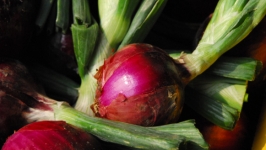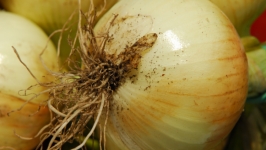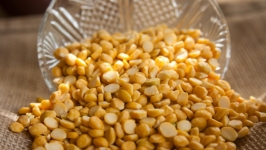Onion Info & Recipes
Discover | Onions are one of the few year-round crops in Michigan. Planting begins around mid-April, harvesting takes place around Labor Day and after harvest onions are cured for storage. By mid-September onions are ready to eat and can be stored and consumed through March. Stored onions thrive in Michigan’s muck soil and cooler climate. Find onions all winter long at indoor farmers’ markets.
Taste | Onions have varied sizes, shapes (flat, round or long) and colors (white, yellow or red). The yellow onion is the most commonly used because of its ideal storage, shipping and cooking qualities. Pungent when raw and sweet when cooked, onions easily adapt to their surroundings. They can be grilled and sliced for a sandwich or featured in a mirepoix for a soup. Cut onions release sulfur-containing fumes that can cause your eyes to water. Be ready to cry, as the average American consumes about 20 pounds of onions per year.
Fortify | Eating onions regularly provides nutritional benefits. They are low in calories, fat and sodium and provide a good source of fiber, vitamin C and potassium. Onions also rank high for quercetin content compared to other vegetables. Quercetin is a compound found in the onion plant that helps defend against environmental toxins. Onions have also been linked to lower blood pressure, increased circulation and lower blood lipids.
Preserve | Purchase the freshest onions that are dry, firm and shiny. They should be heavy, scent free and without any sprouts from the neck. Fresh and properly stored onions can last all winter long. A cool, dry, dark and well-ventilated area is ideal. Place onions in a loosely woven bag with some space to move. Make sure they are far away from the potatoes that like a similar environment. Even though onions are available all winter long, extra chopped onions can be frozen for ease in use in soups and stews. First blanch the chopped onions for 2½ minutes, then cool and drain. Place in a freezer-safe container and use within three to six months









